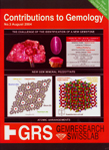| |
| |
The Identification
of the New Gem Mineral Pezzottaite |
|
THE
CHALLENGE OF THE IDENTIFICATION OF A NEW MINERAL SPECIES:
EXAMPLE "PEZZOTTAITE"
Adolf Peretti (1), Thomas Armbruster (2), Detlef Günther
(3), Bernard Grobéty (4), Frank C. Hawthorne (5),
Mark A. Cooper (5), William B. Simmons (6), Alexander U.
Falster (6), George R. Rossman (7), Brendan M. Laurs (8)
(1) GRS Gemresearch Swisslab AG, Hirschmattstr.
6, P.O. Box 4028, CH-6003 Lucerne, Switzerland
(2) Chem. Miner. Kristallogr., University of Berne, Freiestr.
3, CH-3012 Berne, Switzerland
(3) Laboratory of Inorganic Chemistry, ETH Hönggerberg,
HCI, G113, CH-8093 Zurich, Switzerland
(4) Department of Geosciences, University of Fribourg, Pérolles,
CH-1700 Fribourg, Switzerland
(5) Geological Sciences, University of Manitoba, Winnipeg,
Manitoba, Canada R3T 2N2
(6) Geology & Geophysics, University of New Orleans,
New Orleans, Louisiana, LA 70148, USA
(7) Division of Geological & Planetary Sciences, California
Institute of Technology, Pasadena, CA 91125, USA
(8) Gemological Institute of America, Carlsbad, CA 92008,
USA
(Authors (1)-(4) are referred in this article as the "Swiss
research team" and authors
(5)-(8) are referred in this article as the "US-Canadian
research team" |
|
| IDENTIFYING
A NEW GEM MINERAL In
2002, a new gem mineral of commercial importance was
discovered. In accordance with the need for all new
mineral discoveries to be scientifically characterized
(see Nickel and Grice, 1998), the gemological community
anxiously awaited the results of tests to positively
identify the new mineral (Hawthorne et al., 2003,
Hawthorne et al., 2004 and Laurs et al., 2003). This
period of analysis brought into play the question:
Exactly what procedures are necessary for the positive
characterization of a new mineral?
These principal steps
of identification are illustrated in the following
case study for identifying a new mineral of the beryl
group - pezzottaite.
The identification
of this new mineral provided two major challenges:
first, the determination of the exact chemical composition,
and secondly, the identification of its crystallographic
structure (the geometrical arrangement of the atoms
in three dimensions (see Box 1, Figs. P2 and P6).
From special technique of analysis (Boxes 4 and 5A),
the exact stoichiometric chemical formula, and the
space group of this new mineral, have to be determined
(Box 1). As soon as the mineral was characterized
(Boxes 1, 2, 3, 4, 5 & 6), the differences between
already existing minerals had also to be investigated
(see Nickel and Grice, 1998 and Box 5B) and a decision
had to be made regarding whether a new mineral had
been found, and, if so, what would be its new name?
(Hawthorne et al., 2003 and Box 6). In the case of
pezzottaite, these analysis provided major challenges.
As pezzottaite contains light elements - such as hydrogen,
lithium, and beryllium, which cannot be directly analyzed
by quantitative methods commonly used for mineral
analysis such as electron microprobe (EMPA) orXRFanalysis
- direct measurement by Laser Ablation Mass Spectroscopy
was also used (see Box 4B and Fig. P16), as well as
conventional methods used for chemical analysis (Box
4A). In addition to challenges in the analysis of
chemical composition, determination of different atomic
positions in the crystal structure was not trivial.
|
|
A combination of various
analytical techniques was necessary (Figs. P3 and P17)
to finally elaborate the structural differences to beryl
(Figs. P1 and P2 and Box 5B). It was discovered that
the unit-cell of pezzottaite had unusually large dimensions,
which is best described as a superstructure of conventional
beryl (Figs. P1, P2 and P6). Also, the number of atoms
necessary to define the crystal structure turned out
to be unusually high in comparison with other beryl-
group minerals (Boxes 1 and 5). ANALYZING
THE CRYSTAL STRUCTURE
The secrets of the nature of a new mineral
are so small we cannot even identify them with the
help of microscopic magnification. One way to explore
this atomic world is with X-rays (Figs. P3 and P17).
X-rays have a very short wavelength
(with dimensions similar to atoms), allowing them
to penetrate and interact with atoms in a mineral
structure. As atoms group together at very short distances,
X-rays are diffracted when passing through a crystal
and change their direction when they interact with
them. Furthermore, diffracted X-rays interfere with
each other, just like water waves emerging from two
ships. The interaction between atoms and X-rays depends,
among other factors, on the geometrical arrangement
of the atoms and can be interpreted with X-ray diffraction
diagrams, and computer calculations. A diffraction
pattern of a single crystal consists of symmetrically
arranged spots, where the spot separation determines
the periodicity of the lattice (unit-cell dimensions)
and the arrangement of the spots provides clues to
the symmetry of the structure.
Finally, the unit-cell and the space
group can be determined (Boxes 1 and 5A). This is
a crystallographic code that identifies the crystallographic
nature of a mineral. |
|
|
|
|
|
|
|








